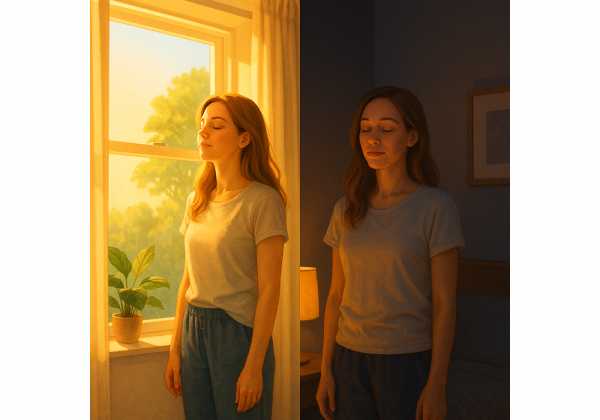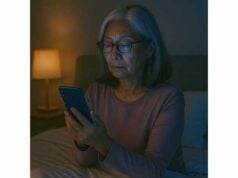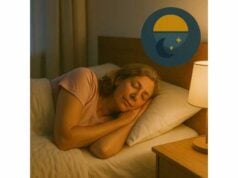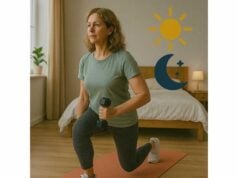
Your body keeps time. Light is its loudest cue. When bright outdoor light reaches the eyes soon after waking, the brain shifts into “day mode,” cortisol rises to productive levels, and the internal clock sets the countdown to tonight’s sleep. When evening light dims—especially the short-wavelength, screen-heavy kind—melatonin rises on schedule, heart rate drops, and the night unfolds with fewer wake-ups. These are everyday actions with compounding value for healthy aging: better sleep consolidation, steadier mood, more reliable energy, and easier weight regulation. This guide turns the science of light and darkness into precise, doable steps for all seasons and schedules, from cloudy winters to busy travel weeks. If you are building a broader plan that aligns sleep, stress, and recovery across the lifespan, explore our hub on sleep and stress for longevity and layer these light habits into your system.
Table of Contents
- Morning Outdoor Light: Timing, Duration, and Angle
- Cloudy Days and Winter: Getting Enough Light Exposure
- Evening Darkness Routine: Dimming, Warm Light, and Screens
- Indoor Lighting Choices: Bulbs, Lamps, and Placement
- Digital Sundown: Notifications, Apps, and Night Modes
- Weekly Checklist: Habits That Keep Your Clock Aligned
- What to Track: Sleep Latency, Mood, and Energy Stability
Morning Outdoor Light: Timing, Duration, and Angle
The goal: anchor your circadian clock each morning so tonight’s sleep arrives on time and holds. The most reliable lever is outdoor light soon after waking—ideally when the sun is still low on the horizon. Short-wavelength (blue-enriched) daylight and a broad spectral mix stimulate the retina’s intrinsically photosensitive ganglion cells, sending a robust “daytime” signal to the suprachiasmatic nucleus (your master clock). That signal advances the clock when taken early enough, increasing evening sleepiness on schedule.
Timing. Step outside within 60 minutes of waking (within 30 minutes if you are trying to shift earlier). The earlier the exposure in your day, the stronger the advance on the next night’s sleep, especially if you also keep your wake time stable.
Duration and intensity. Aim for 30–60 minutes of outdoor exposure most mornings. Even under shade or light cloud cover, daylight delivers far more photopic lux and melanopic stimulus than typical indoor lighting. If your schedule allows only 10–15 minutes at once, split it: two or three short outdoor breaks still add up, and the circadian system integrates multiple bouts across the day.
Angle. Early light is not only bright; it arrives from a lower solar angle that better engages circadian pathways. If you can see the sky without squinting—on a walk, balcony, or near an open window with a clear view—you are likely getting enough signal. Sunglasses are fine for comfort, but if you are using very dark lenses every morning, consider brief un-tinted exposure when safe and comfortable.
Practical ways to build the habit
- Make it automatic. Pair morning light with a task you already do: a short walk after coffee, pet care outside, or reading on a porch.
- Stack with movement. A 10–20 minute brisk walk compounds benefits: temperature rises, sleep pressure builds for tonight, and mood lifts.
- Use the calendar. Shift your first meeting or heavy creative work to a slot after your light walk. That slight friction encourages consistency.
- Avoid bright screens before outdoor light. If you must check messages, keep brightness low and hold the device farther from the eyes until you get outside.
If you wake before sunrise. Use indoor light to start the day (more on bulbs below), then go outside after sunrise for 10–20 minutes to top up the circadian cue. Maintain the total 30–60 minutes across the morning when possible.
What not to do. Do not rely on a bright desk lamp as your only morning anchor. Most indoor setups deliver one to two orders of magnitude less melanopic stimulus than outdoor light. Save indoor lighting tweaks for when weather or safety keeps you inside.
Anchoring mornings this way makes evening dimming more effective and reduces the “second wind” late at night. It also stabilizes energy and appetite cues during the day, which nudges healthier meal timing and activity—two more levers that support tonight’s sleep.
Cloudy Days and Winter: Getting Enough Light Exposure
Short days and overcast skies can cut your natural light dose. The fix is not perfection—it is practical redundancy: more short exposures, smart positioning, and backup tools when weather or darkness dominates.
Use the sky you have. Even heavy overcast outdoors often beats a well-lit office by a wide margin. If rain or cold keeps you close to home, stand under an awning or open garage with a clear view of the sky for 10–15 minutes, 2–3 times in the morning. Add a brisk stair climb or a loop around the block to raise body temperature and alertness.
Window strategy. Windows attenuate and change the spectrum of daylight, but a large, unobstructed window still delivers more useful circadian stimulus than most room lighting. Work near that window for your first 90 minutes if you cannot be outdoors. Open blinds fully; position your workspace to face the window without glare.
Midday top-ups. In winter, add one 10–15 minute outdoor top-up between late morning and early afternoon. The circadian system integrates across exposures, so these small deposits matter.
Light therapy devices: when and how. Consider a certified bright-light box (commonly 10,000 lux at a set distance) if you live at high latitude, struggle with sluggish mornings, or experience seasonal mood dips. Use it upon waking, eyes open, positioned slightly off-axis at the manufacturer’s distance (often 30–60 cm), for 20–30 minutes. Do not stare directly at the lamp; read or work nearby. For shift workers or those with a delayed sleep phase, timing adjustments are crucial—pair morning use with reduced evening light to avoid pushing your schedule later.
Movement and meals help the signal travel. On short, dark days, double down on morning movement (even a 10-minute mobility circuit) and keep meal timing consistent. Morning light plus activity plus regular meals provides converging time cues that keep your clock from drifting. For a broader circadian reset playbook, see body-clock strategies that hold in all seasons.
Safety and eye comfort. Sensitive eyes? Try shorter, repeated sessions and build tolerance. If you have retinal disease or are on photosensitizing medications, ask your clinician before using high-intensity lamps.
Travel and latitude changes. When flying east into winter mornings, seek outdoor light the first local morning even if dim. When flying west, delay your strongest outdoor exposure toward late local morning to avoid pushing the clock too early. In both cases, reduce evening light aggressively for two to three nights.
Winter is not the enemy; light variability is. Multiply small, consistent exposures and keep your wake time fixed. The cumulative signal will keep your sleep on schedule even when the sun seems scarce.
Evening Darkness Routine: Dimming, Warm Light, and Screens
Evenings decide the ease of sleep onset. The brain expects darkness—low intensity and a spectrum depleted in short wavelengths—for two to three hours before bed. You do not need a cave; you need a trackable routine that turns the light dial down, protects melatonin rise, and reduces cognitive arousal.
A simple 90-minute runway
- T-90 to T-60: Turn off bright overheads. Use table or floor lamps with warm-white bulbs (≤3000 K) and set them below eye level. Finish screen-heavy or stimulating tasks now.
- T-60: Do the “brain unload”: write tomorrow’s three key tasks. Tidy your space for five minutes to reduce visual noise.
- T-45: Warm shower or bath. As you cool afterward, core temperature drops, which eases sleep onset.
- T-30: Quiet reading, gentle stretching, or a brief body scan. Keep screens aside; if you must use one, keep it dim, distant, and brief.
- Lights-out: Same time most nights (weekends included while recalibrating).
Screen pragmatics. Night modes and filters help, but brightness and distance matter most. Reduce brightness to the lowest comfortable level and hold devices farther from the eyes. Prefer a television across the room to a phone a handspan away. If you are sensitive, consider blue-depleted or very warm display settings after sunset.
Household strategies
- Replace one or two key bulbs in the living room and bedroom with warm-white, lower-lumen options.
- Use lamps instead of ceiling cans at night; a lower angle reduces retinal stimulus.
- Put motion-activated night lights with very warm output (amber) in hallways for bathroom trips.
- Institute a kitchen cutoff two to three hours before bed. Late meals raise temperature and can fragment early sleep.
Alcohol and “tired but wired.” Alcohol feels relaxing but lightens sleep and blunts REM. If your pattern is “I’m sleepy at 9, then wake up wired at 11,” combine a no-alcohol evening, warmer shower, and dim lighting for three nights. Expect a clear shift in latency and fewer awakenings.
If you have a history of lying awake despite good habits, pair evening dimming with cognitive-behavioral skills for insomnia—stimulus control and a tightened time-in-bed window. For step-by-step support, see our guide to practical CBT-I that fits real schedules.
Your evening light routine is less about gadgets and more about predictability. When the brain sees the same dimming pattern, it learns. After 7–10 days, most people report an earlier wave of sleepiness and smoother nights.
Indoor Lighting Choices: Bulbs, Lamps, and Placement
Because we spend much of our lives indoors, your lighting layout either supports your clock or works against it. The good news: a few deliberate choices can turn your home into a day–night system without turning it into a lab.
Day mode (wake hours)
- Aim: bright, diffuse, eye-level or higher illumination for work areas.
- What to use: ceiling fixtures or high floor lamps with bright, neutral–cool bulbs in spaces you occupy most before noon (kitchen, home office).
- Practical spec: select bulbs with high output and consider neutral to cooler CCT (3500–5000 K) for daytime task areas. Combine with natural daylight from windows; keep blinds open.
Evening mode (wind-down hours)
- Aim: low-intensity, warm, below eye level.
- What to use: table lamps, wall sconces, or low floor lamps with ≤3000 K bulbs. Ditch bright overheads after sunset in rooms you use at night.
- Practical spec: pick bulbs that dim smoothly without flicker; if your fixtures do not dim, use lower-lumen bulbs in evening lamps.
Placement matters
- Height: Light from above eye level is more stimulating at night. Use shaded lamps that cast light downward in the evening.
- Distance: Keep bright lamps farther from where you sit after sunset.
- Contrast: Avoid dark rooms with one bright point (e.g., a single lamp); instead, use two or three low-level lamps to reduce glare while keeping total intensity modest.
Bedrooms and hallways
- Motion lights: Install warm, low-lumen lights along the floor or baseboards to guide bathroom trips without flooding the eyes.
- Reading lamps: Choose adjustable lamps with narrow beams, pointed at pages rather than eyes.
- Alarm strategy: Morning clocks with gradual light can be useful before sunrise; still, step outside after actual sunrise to finish the cue.
Work-from-home upgrades on a budget
- Move your desk near a window and use a brighter overhead during the first half of the day.
- After sunset, switch to two low lamps placed beyond arm’s reach.
- Keep a clip-on warm lamp in your reading spot; turn off overheads when it’s on.
These decisions build a home that speaks circadian: bright and diffuse by day, dim and warm by night. They also dovetail with classic sleep-hygiene steps—cooler bedrooms, quieter spaces, and a predictable wind-down. For a fuller room-by-room checklist, see our guide to sleep-friendly environments.
Digital Sundown: Notifications, Apps, and Night Modes
Even with perfect lamps, screens can undo your evening gains. The fix is not abstinence; it is structure—turning screens from “always on” to scheduled, dim, and distant.
Set your digital sunset
- Choose a time 2–3 hours before bed when non-urgent notifications stop. Use Do Not Disturb and Focus Modes with a whitelist (family, urgent calls).
- Move devices out of reach. Put the phone on a shelf or across the room; pick up a paper book or a dedicated e-reader with front-light set to very warm and very dim.
- Switch contexts. If you watch TV, sit farther away and dim the room; distance reduces retinal stimulus far more than app filters.
Night modes help—brightness and distance help more
- Enable night shift or blue-reduced modes on all devices from sunset to dawn.
- Reduce screen brightness to the lowest comfortable level, then reduce it again after five minutes.
- Read or watch from across the room rather than at arm’s length. Tablets and phones near the eyes deliver a much larger melanopic dose.
App hygiene
- Audit your home screen; remove attention traps (social feeds) from the first page.
- Create a two-icon “evening row”: audiobook, e-reader. Make them easy—which nudges you to default to them after dinner.
Cognitive arousal is the stealth saboteur
Even with dim screens, engaging content (work email, news outrage, intense shows) fuels arousal. Replace with low-stakes inputs after your digital sunset: nature docs, light fiction, music. Keep the last 30 minutes device-free when possible.
If you struggle with “just one more scroll”
- Use app timers that lock addictive apps after a daily limit.
- Charge your phone outside the bedroom; use a simple alarm clock instead.
- Make a pact: if you reopen the phone after bedtime once, you must stand up and go to a chair. The friction alone reduces repeats.
If insomnia patterns have taken hold—spending long periods awake in bed or a rising fear of bedtime—pair digital sundown with targeted behavioral tools. Our plain-English CBT-I guide (skills for insomnia) shows how to rebuild sleep drive and retrain the brain to associate bed with sleep, not scrolling.
Weekly Checklist: Habits That Keep Your Clock Aligned
Circadian health is a practice, not a gadget. The most durable wins come from a handful of small moves repeated most days. Use this checklist as a weekly audit; it fits busy lives and adapts to seasons.
Daily anchors
- Wake time fixed (±30 minutes) all week.
- Morning outside within 60 minutes of waking for 30–60 minutes total across one or more bouts.
- Evening dimming starts 2–3 hours before bed: no overheads, warm lamps, low screens, short wind-down.
- Meal rhythm: finish dinner 2.5–3 hours before bed; keep breakfast timing consistent.
- Movement: a minimum 10–20 minute morning walk or mobility routine; 150–300 minutes/week of moderate activity total plus 2–3 resistance sessions.
Weekly rhythm
- One outdoor block longer than usual (e.g., a 60–90 minute weekend walk) to backstop a cloudy workweek.
- Bedroom reset: wash breathable bedding, verify room temp (17–19°C), and check that night-lights are warm and low.
- Device audit: confirm Focus Modes and app limits are still active and aligned with your current bedtime.
Travel and social shifts
- For a late night out, hold the morning wake time, get extra morning light, and nap early if needed (<30 minutes before mid-afternoon).
- Crossing time zones? Use a pre-shift: adjust your morning light and bedtime by 30–60 minutes for two days before the trip, and follow local morning light immediately on arrival. For structured reset tactics, see jet-lag strategies you can apply without guesswork.
If sleep slips
- Re-anchor with two strict mornings: outside within 30 minutes of waking, a short walk, and early, warm dinners.
- Guard the two hours before bed ruthlessly: dim, quiet, and low-stakes inputs.
- If you still struggle, tighten time in bed for three to five nights (go to bed later, wake at the same time) to rebuild sleep pressure.
Mindset that sticks
Think “usually,” not “always.” You do not need perfection to benefit; you need repeatability. Missing a night? Make the next morning count. Over time, these small commitments pay off as earlier waves of sleepiness, fewer awakenings, and steadier daytime energy.
What to Track: Sleep Latency, Mood, and Energy Stability
You do not need a lab to know whether morning light and evening dimming work for you. A two-week experiment with simple metrics will show clear trends and guide adjustments.
Before you start (3 days)
- Keep your current routine.
- Record: bedtime/wake time, sleep latency (estimate in five-minute bins), number and duration of awakenings, total sleep time (estimate), morning energy (0–10), and midday mood (0–10).
- Note morning outside minutes, evening light practices, caffeine after noon, and alcohol. These context notes help explain changes.
Run the protocol (days 4–14)
- Morning: outside within 60 minutes; total 30–60 minutes across one or more bouts. If it is dark at wake time, use indoor light first, then go outside after sunrise.
- Evening: start dimming 2–3 hours before bed; swap to warm lamps; keep screens dim and distant; end heavy work early.
- Meals: finish dinner 2.5–3 hours before bed.
- Movement: 10–20 minute morning walk plus your usual activity.
Track nightly
- Latency and wake after sleep onset (WASO).
- Time outdoors before noon (minutes).
- Evening light score (0–3): 0 = overheads all evening; 1 = some dimming; 2 = lamps only; 3 = lamps + no close screens last hour.
- Morning energy and mood at 9–11 a.m. (0–10).
- Optional: resting heart rate (RHR) on a wearable; look for a downward trend of 2–4 bpm over 1–2 weeks, which often accompanies better sleep timing and depth.
What success looks like
- Latency drops by 15–20 minutes on average.
- WASO shrinks by 15–30 minutes or total awakenings fall by 1–2.
- Morning energy rises by 1–2 points and feels more stable across the week.
- RHR trends lower and wake time becomes easier to hold steady.
Adjustments if progress stalls
- Shift light earlier. Move your first outdoor block closer to wake time or extend total morning minutes.
- Dim harder. Replace one overhead with a lamp, lower brightness on the TV further, or move viewing farther away.
- Lock the wake time. It is the metronome. Even a weekend wobble can erase gains.
- Add a midday top-up. 10–15 minutes outside late morning or early afternoon helps when mornings are rushed.
When to seek extra help
If, after two weeks of consistent light habits, you still face prolonged insomnia, loud snoring, or daytime sleepiness that impairs safety, pursue a targeted evaluation. Light and darkness set the stage; medical issues like sleep apnea, restless legs, depression, and medication effects may still need attention.
Your closing step: keep the minimum viable routine—morning outside, evening dimming, and a steady wake time. These three pillars make every other sleep tool more effective, from exercise timing to stress management.
References
- Recommendations for daytime, evening, and nighttime indoor light exposure to best support physiology, sleep, and wakefulness in healthy adults 2022 (Consensus Report)
- Effects of light on human circadian rhythms, sleep and mood 2019 (Review)
- Evening use of light-emitting eReaders negatively affects sleep, circadian timing, and next-morning alertness 2015 (RCT)
- Melanopic irradiance defines the impact of evening display light on sleep latency, melatonin and alertness 2023 (Experimental Study)
- Linking Light Exposure and Subsequent Sleep: A Field Polysomnography Study in Humans 2017 (Field Study)
Disclaimer
This information is educational and not a substitute for personalized medical advice. Always consult your healthcare professional before changing therapies or using light-therapy devices, especially if you have eye disease, photosensitivity, mood disorders, or shift-work constraints. Seek prompt evaluation for persistent insomnia, loud snoring with witnessed pauses, or excessive daytime sleepiness.
If this guide was helpful, please consider sharing it on Facebook, X (formerly Twitter), or any platform you prefer, and follow us for future updates. Your support helps us continue creating careful, evidence-based resources for healthy aging.










